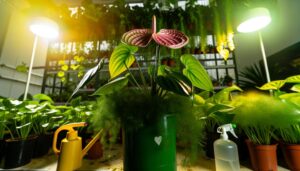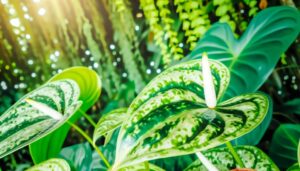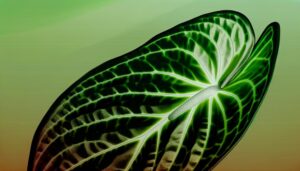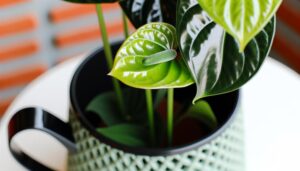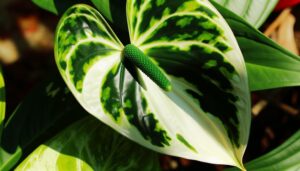10 Essential Steps for Caring for an Anthurium Scherzerianum
Caring for Anthurium Scherzerianum demands adherence to specific environmental and maintenance steps. Position the plant in bright, indirect light and maintain stable temperatures between 65-75°F (18-24°C) with high humidity.
Guarantee proper air circulation, avoiding vents. Water when the top inch of soil is dry and fertilize according to growth rates and light exposure.
Use sterilized tools for pruning, and repot using a well-draining soil mix during the active growth season. Regularly inspect for pests and diseases, taking immediate action if necessary.
Your successful plant care journey starts with mastering these foundational steps.
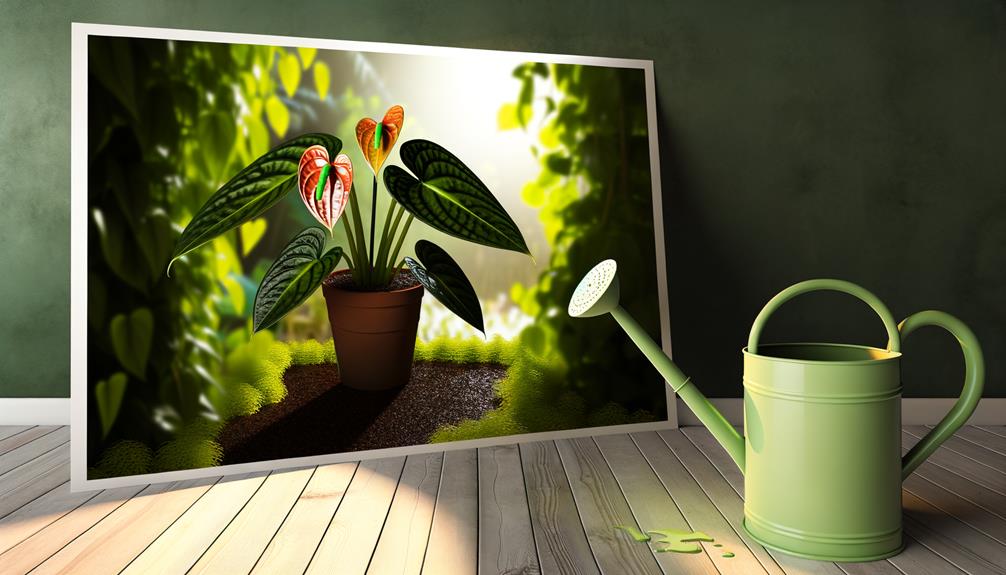
Key Takeaways
- Position Anthurium Scherzerianum in bright, indirect light to avoid photodamage.
- Maintain temperature between 65-75°F (18-24°C) and high humidity levels of 70-80%.
- Water when the top inch of soil is dry, ensuring good drainage to prevent overwatering.
- Apply diluted fertilizer seasonally, adjusting frequency and strength based on growth and light exposure.
- Regularly inspect for pests and diseases, using neem oil or insecticidal soap as needed.
Choose the Right Location
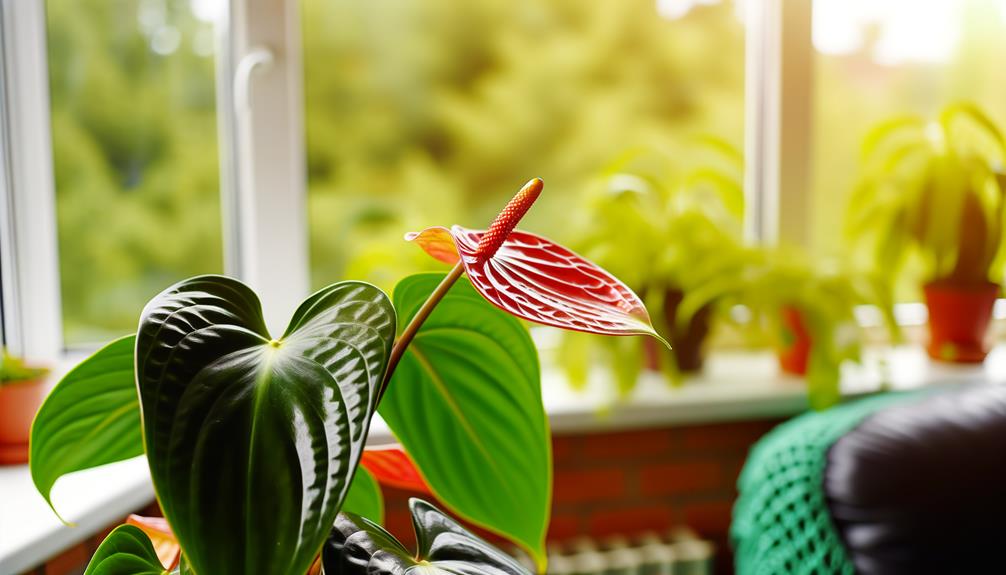
Selecting an ideal spot for your Anthurium Scherzerianum is vital, as it depends on a balance of indirect light, consistent temperature, and sufficient humidity to thrive. Position your Anthurium in a place where it can benefit from stable ambient conditions.
Aim for a temperature range between 65-75°F (18-24°C), avoiding cold drafts and sudden fluctuations. High humidity is essential; placing the plant in a naturally humid environment such as a bathroom or using a humidity tray can be advantageous.
Ensure the location has good air circulation to prevent fungal issues, but avoid placing it directly in front of heating or cooling vents. These environmental factors collectively contribute to the best growth and health of your Anthurium Scherzerianum.
Provide Proper Lighting
Ensuring your Anthurium Scherzerianum receives proper lighting is crucial for its photosynthesis and overall growth.
This tropical plant thrives in bright, indirect light, which mimics the dappled sunlight of its native rainforest habitat. Direct sunlight can scorch the leaves, leading to photodamage and reduced health. Best placement is near a north or east-facing window, where it can benefit from diffused light.
If natural light is insufficient, consider using fluorescent grow lights to provide the necessary illumination. These lights should be positioned 12-24 inches above the plant to prevent overheating and guarantee even light distribution.
Monitoring light levels with a lux meter can help maintain the ideal range of 10,000 to 20,000 lux for top growth.
Maintain Optimal Temperature
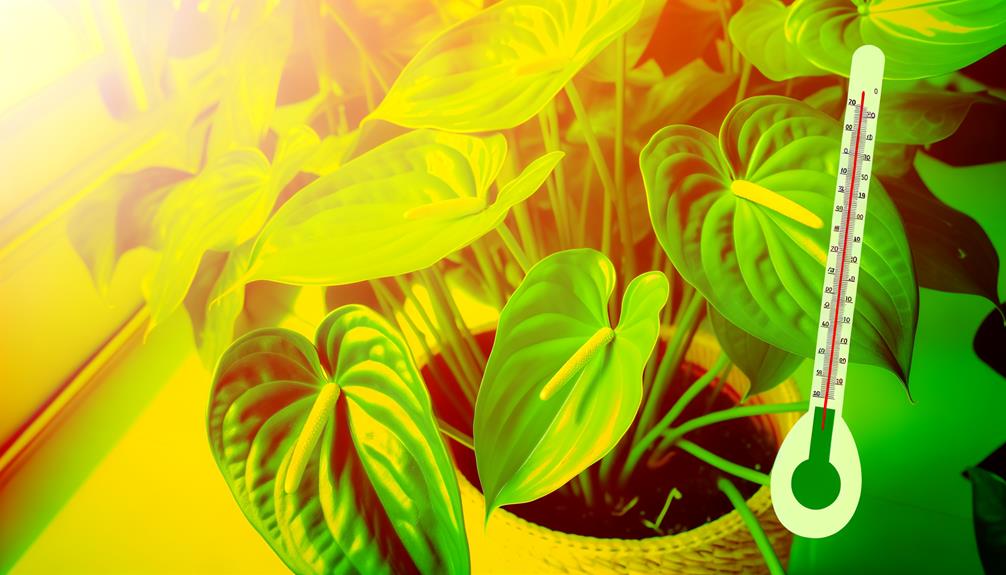
To guarantee the Anthurium Scherzerianum thrives, it is essential to maintain an ideal temperature range of 65-75°F (18-24°C).
Consistent temperatures within this range support healthy growth and vibrant blooms, while exposure to sudden temperature fluctuations can stress the plant, leading to potential damage.
It is advisable to keep the plant away from drafty windows, heating vents, and air conditioning units to mitigate temperature inconsistencies.
Ideal Temperature Range
Maintaining an ideal temperature range between 65°F and 75°F (18°C to 24°C) is crucial for the healthy growth and vibrant blooms of Anthurium scherzerianum. This temperature spectrum supports peak metabolic and physiological processes, promoting robust photosynthesis and nutrient uptake.
Consistently maintaining these temperatures can prevent stress, which often leads to reduced flowering and weaker plant health. Cooler temperatures below 60°F (15°C) can slow growth and induce dormancy, while temperatures above 80°F (27°C) may cause wilting and foliar damage.
Indoor cultivation requires monitoring ambient conditions, utilizing thermostats, and providing adequate ventilation. By adhering to this temperature range, one can optimize the Anthurium scherzerianum thrives and displays its characteristic bright, spadix-centered flowers.
Avoid Temperature Fluctuations
Fluctuations in temperature can severely disrupt the metabolic stability and physiological health of Anthurium scherzerianum, making it crucial to maintain a consistent environment within the ideal temperature range.
Sudden changes, either increases or decreases, can cause stress to the plant, showing in leaf discoloration, reduced flowering, and stunted growth.
The best temperature for Anthurium scherzerianum is typically between 70-85°F (21-29°C) during the day and 60-70°F (15-21°C) at night.
To mitigate temperature fluctuations, avoid placing the plant near drafts, heating vents, or air conditioning units.
Monitoring indoor climate with a reliable thermometer and using humidifiers or heaters as necessary can further optimize stable conditions, thereby promoting robust growth and longevity of the Anthurium scherzerianum.
Ensure Correct Humidity
Ideal humidity levels for Anthurium Scherzerianum should be maintained between 70% and 80% to replicate its native tropical environment. This high humidity is essential for best growth and vibrant blooms. Utilizing a hygrometer to regularly monitor humidity levels is recommended.
If natural humidity is insufficient, consider using a humidifier or placing the plant on a humidity tray filled with water and pebbles. Grouping plants together can also enhance local humidity through collective transpiration.
Additionally, avoid placing the plant near air vents or drafts, as these can greatly reduce humidity levels. Ensuring proper humidity not only supports healthy foliage but also reduces the risk of pest infestations and leaf browning, common issues in drier conditions.
Watering Guidelines
Watering an Anthurium Scherzerianum requires a balanced approach to maintain ideal soil moisture without causing root rot.
It is advisable to water the plant when the top inch of soil becomes dry, ensuring sufficient hydration while preventing oversaturation.
Monitoring the plant's environment and adjusting watering frequency accordingly can mitigate overwatering issues and promote healthy growth.
Optimal Watering Frequency
Proper hydration is crucial for maintaining the health of Anthurium scherzerianum, with the plant typically requiring watering once the top inch of soil feels dry to the touch. This species thrives in consistently moist yet well-drained soil, necessitating a precise balance.
Employ a regular schedule, generally every 5-7 days, adjusting for environmental conditions such as humidity and temperature. Utilize room-temperature water to avoid shocking the root system. Ensure water is evenly distributed to promote uniform moisture levels throughout the substrate.
Employing a pot with drainage holes is essential to facilitate excess water egress, preventing potential root hypoxia. Regular monitoring of soil moisture with a hygrometer is recommended to maintain optimal hydration levels and support the plant's physiological needs.
Preventing Overwatering Issues
To avoid the detrimental effects of overwatering, it is imperative to establish a meticulous watering protocol that aligns with the specific moisture requirements of Anthurium scherzerianum. This species thrives in conditions where the soil is consistently moist but not waterlogged. Utilize a well-draining potting mix to prevent water accumulation.
Regularly check the top inch of soil; water only when it feels dry to the touch. Employ pots with drainage holes to facilitate excess water escape. Consider the ambient humidity, adjusting watering frequency during high-humidity periods.
Implement a schedule that accommodates seasonal variations, as overwatering is more prevalent during cooler months. Monitoring for signs of root rot or yellowing leaves can provide early detection of overwatering issues.
Use Suitable Soil
Choosing the suitable soil mix is crucial for ensuring ideal growth and health of Anthurium Scherzerianum, as this tropical plant requires a well-draining, aerated medium rich in organic matter. A specialized soil blend is necessary to replicate its natural epiphytic environment, promoting robust root development and preventing root rot. Optimal soil should retain some moisture while allowing excess water to escape promptly.
Recommended soil components include:
- Orchid bark: Enhances aeration and drainage.
- Peat moss: Provides moisture retention and organic matter.
- Perlite: Improves drainage and prevents compaction.
- Coconut coir: Offers lightweight structure and water retention.
- Charcoal: Assists in absorbing impurities and maintaining soil health.
These elements collectively create a balanced substrate conducive to the plant's vigorous and sustained growth.
Fertilizing Schedule
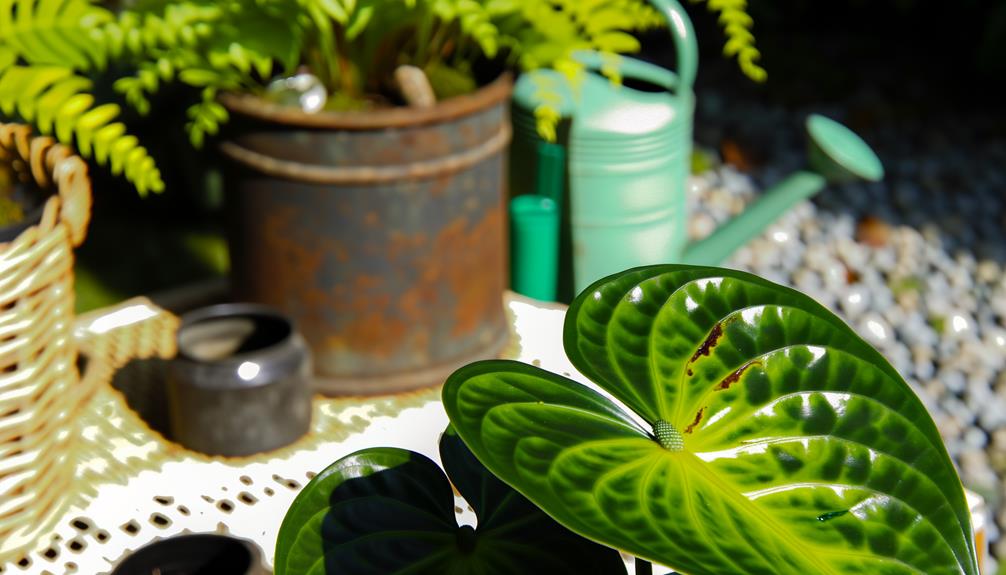
Establishing an ideal fertilizing schedule for Anthurium Scherzerianum involves precise nutrient timing, tailored to its growth phases. Comparing various fertilizer types—particularly balanced, slow-release, and liquid formulations—can help identify the most effective options.
Seasonal adjustments are essential, as nutrient requirements shift between active growth periods and dormancy.
Optimal Nutrient Timing
Proper nutrient timing for Anthurium Scherzerianum involves applying a balanced, water-soluble fertilizer biweekly during the growing season from spring to early autumn. This guarantees sustained nutrient availability to support vigorous growth and vibrant blooms.
Consistent feeding is critical, as nutrient deficiencies can lead to stunted growth and poor flower production. Here are some key considerations to optimize nutrient timing:
- Verify the soil is moist before applying fertilizer to prevent root burn.
- Use half-strength fertilizer solutions to avoid over-fertilization.
- Adjust the frequency to weekly in periods of rapid growth or high light exposure.
- Monitor plant health and adjust the schedule based on visual cues.
- Reduce fertilization frequency during the dormant winter months.
Fertilizer Types Comparison
While considering the fertilization schedule for Anthurium Scherzerianum, it is crucial to compare different fertilizer types, such as granular, liquid, and slow-release formulations, to determine the most effective option for sustained nutrient delivery. Granular fertilizers offer a straightforward application but require careful dosage to prevent root burn. Liquid fertilizers provide immediate nutrient availability but necessitate frequent applications. Slow-release fertilizers guarantee a steady nutrient supply over time, which can be particularly advantageous for consistent growth. Below is a comparative table delineating key attributes of each fertilizer type:
| Fertilizer Type | Application Frequency | Nutrient Release Rate |
|---|---|---|
| Granular | Monthly | Rapid |
| Liquid | Bi-weekly | Immediate |
| Slow-Release | Every 3-6 months | Gradual |
Selecting the appropriate type hinges on balancing convenience with the plant's nutritional demands.
Seasonal Adjustments Needed
Adapting the fertilizing timetable for Anthurium Scherzerianum according to seasonal changes is essential to maximize nutrient uptake and plant health. During the active growth phase in spring and summer, apply a balanced liquid fertilizer every four to six weeks to support vigorous growth.
In contrast, reduce fertilizing frequency to once every eight weeks during the fall and winter when the plant's growth rate diminishes. Always maintain proper dilution to avoid root burn.
Spring/Summer:
- Fertilize every 4-6 weeks
Fall/Winter:
- Fertilize every 8 weeks
Dilution:
- Follow manufacturer's instructions to avoid over-fertilization
Signs of Need:
- Yellowing leaves may indicate nutrient deficiency
Watering:
- Water before fertilizing to prevent root damage
This schedule ensures optimal health and longevity for your Anthurium Scherzerianum.
Pruning and Trimming
To maintain the health and appearance of an Anthurium Scherzerianum, precise and regular pruning is vital. Begin by sterilizing pruning shears to prevent disease transmission.
Remove any yellowing or damaged leaves at their base to promote new growth and reduce resource strain. Trim spent flowers by cutting the stems just above the leaf node, which directs energy back into the plant.
Additionally, thin out overcrowded areas to improve air circulation, mitigating fungal issues. Inspect for pests and diseases during pruning sessions, addressing any problems promptly.
Repotting Tips
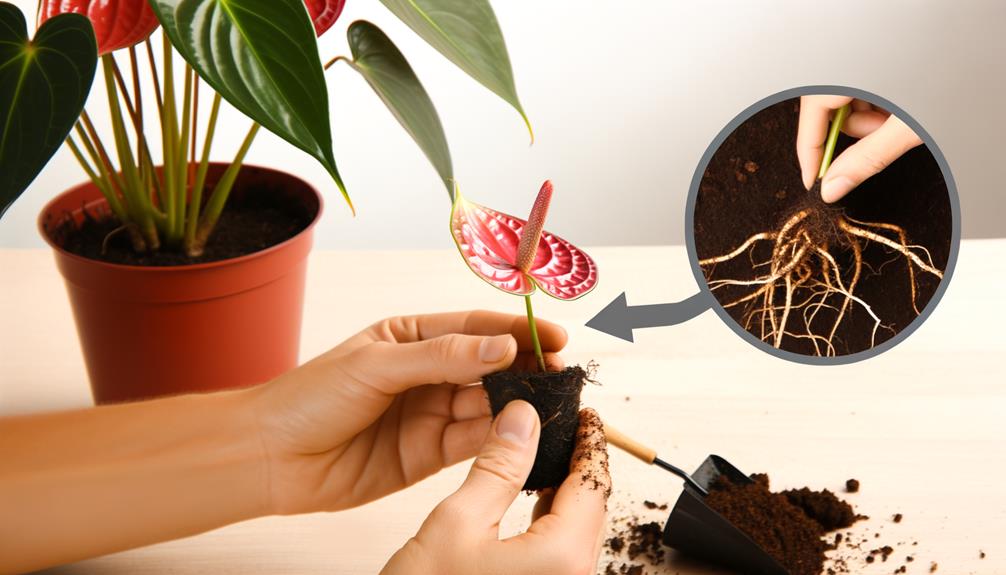
Repotting an Anthurium Scherzerianum requires careful attention to root health and selecting an appropriate soil mix to guarantee ideal growth conditions. Make sure to repot during the plant's active growing season, typically in spring, for best adaptation.
Use a potting mix that offers excellent drainage yet retains some moisture, such as a combination of orchid bark, perlite, and peat moss. Gently remove the plant from its current pot, shake off excess soil, and inspect the roots for any signs of rot or damage, trimming as necessary.
- Choose a pot that is 1-2 inches larger in diameter than the current one.
- Ensure the new pot has sufficient drainage holes.
Water the plant thoroughly after repotting. Avoid direct sunlight immediately after repotting. Monitor soil moisture levels closely after repotting.
Monitor for Pests and Diseases
Vigilance in monitoring an Anthurium Scherzerianum for pests and diseases is crucial to maintaining the plant's health and preventing potential infestations or infections.
Regularly inspect both the upper and lower surfaces of the leaves for common pests such as aphids, spider mites, and mealybugs. Early detection can be achieved through visual checks and the use of a magnifying glass if necessary.
Additionally, be aware of disease symptoms such as leaf spots, yellowing, or wilting, which may indicate bacterial or fungal infections. Implementing a routine spraying regimen with neem oil or insecticidal soap can mitigate pest issues.
To prevent disease, ensure proper air circulation, avoid overwatering, and remove any affected foliage promptly. This proactive approach will sustain the plant's vigor and aesthetic appeal.
Conclusion
The complete care of Anthurium scherzerianum involves careful attention to location, lighting, temperature, humidity, watering, fertilizing, pruning, repotting, and pest management.
For example, a case study involving a conservatory in the Netherlands showed that keeping a humidity level of 70-80% and providing indirect sunlight greatly enhanced the plant's vigor.
Following these guidelines guarantees the best growth and health of Anthurium scherzerianum, enhancing its longevity and ornamental worth.

